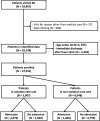Efficacy of a four-tier infection response system in the emergency department during the coronavirus disease-2019 outbreak
- PMID: 34383840
- PMCID: PMC8360518
- DOI: 10.1371/journal.pone.0256116
Efficacy of a four-tier infection response system in the emergency department during the coronavirus disease-2019 outbreak
Abstract
Introduction: The coronavirus disease (COVID-19) pandemic has delayed the management of other serious medical conditions. This study presents an efficient method to prevent the degradation of the quality of diagnosis and treatment of other critical diseases during the pandemic.
Methods: We performed a retrospective observational study. The primary outcome was ED length of stay (ED LOS). The secondary outcomes were the door-to-balloon time in patients with suspected ST-segment elevation myocardial infarction and door-to-brain computed tomography time for patients with suspected stroke. The outcome measures were compared between patients who were treated in the red and orange zones designated as the changeable isolation unit and those who were treated in the non-isolation care unit. To control confounding factors, we performed propensity score matching, following which, outcomes were analyzed for non-inferiority.
Results: The mean ED LOS for hospitalized patients in the isolation and non-isolation care units were 406.5 min (standard deviation [SD], 237.9) and 360.2 min (SD, 226.4), respectively. The mean difference between the groups indicated non-inferiority of the isolation care unit (p = 0.037) but not in the patients discharged from the ED (p>0.999). The mean difference in the ED LOS for patients admitted to the ICU between the isolation and non-isolation care units was -22.0 min (p = 0.009). The mean difference in the door-to-brain computed tomography time between patients with suspected stroke in the isolation and non-isolation care units was 7.4 min for those with confirmed stroke (p = 0.013), and -20.1 min for those who were discharged (p = 0.012). The mean difference in the door-to-balloon time between patients who underwent coronary angiography in the isolation and non-isolation care units was -2.1 min (p<0.001).
Conclusions: Appropriate and efficient handling of a properly planned ED plays a key role in improving the quality of medical care for other critical diseases during the COVID-19 outbreak.
Conflict of interest statement
The authors have declared that no competing interests exist.
Figures




References
-
- Chudasama YV, Gillies CL, Zaccardi F, Coles B, Davies MJ, Seidu S, et al.. Impact of COVID-19 on routine care for chronic diseases: A global survey of views from healthcare professionals. Diabetes Metab Syndr. 2020;14(5):965–7. Epub 2020/07/01. doi: 10.1016/j.dsx.2020.06.042 ; PubMed Central PMCID: PMC7308780. - DOI - PMC - PubMed
-
- Mafham MM, Spata E, Goldacre R, Gair D, Curnow P, Bray M, et al.. COVID-19 pandemic and admission rates for and management of acute coronary syndromes in England. Lancet. 2020;396(10248):381–9. Epub 2020/07/18. doi: 10.1016/S0140-6736(20)31356-8 ; PubMed Central PMCID: PMC7429983. - DOI - PMC - PubMed
-
- Sung CW, Lu TC, Fang CC, Huang CH, Chen WJ, Chen SC, et al.. Impact of COVID-19 pandemic on emergency department services acuity and possible collateral damage. Resuscitation. 2020;153:185–6. Epub 2020/06/26. doi: 10.1016/j.resuscitation.2020.06.021 ; PubMed Central PMCID: PMC7308005. - DOI - PMC - PubMed
-
- Maria FM, Lorena MR, Maria Luz FV, Cristina RV, Dolores PD, Fernando TF. Overall management of emergency general surgery patients during the surge of the COVID-19 pandemic: an analysis of procedures and outcomes from a teaching hospital at the worst hit area in Spain. Eur J Trauma Emerg Surg. 2021;47(3):693–702. Epub 2021/01/06. doi: 10.1007/s00068-020-01558-z ; PubMed Central PMCID: PMC7782559. - DOI - PMC - PubMed
Publication types
MeSH terms
LinkOut - more resources
Full Text Sources
Medical

